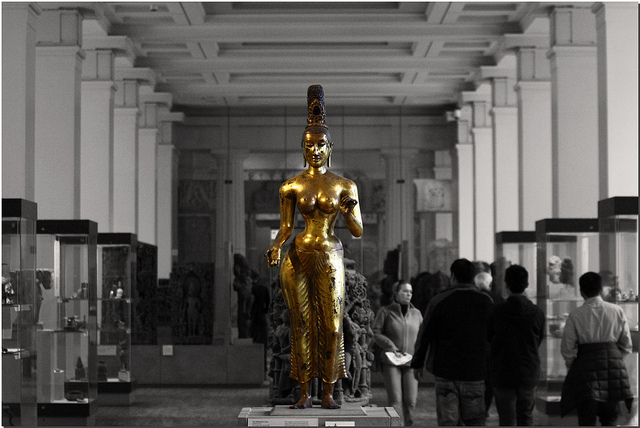Much of India’s treasures have been looted and are either displayed in museums or in private collections around the world .On a visit to the British Museum one Hindu finds something very interesting….
In January of 2011 I went to the British Museum in London. For a lifelong student of history it was a dream come true. The Rosetta stone is there, the actual sculptures from the face of the Parthenon. There are mummies, sarcophagi, amulets, all the minutia of spiritual life. Nothing but a pane of glass between you and the relics of the distant past, their significance as objects of immediate and ongoing potency vanished scarcely mentioned on the placards identifying them.
They were the spoils of war and the loot of empire – whole temples moved round the world for the study of European intellectuals.
I made my way to the India collection, and there, very close to the floor, were some beautifully carved deities of Krishna, and Vishnu, and Hanuman. Here were the material culture of my own faith lying alongside the artifacts of the Indo-European tradition that was wiped out by the Roman state during the later years of the empire.
“…those black-garbed people … run to the temples, bringing with them wood, and stones, and iron … the roofs are uncovered, walls are pulled down, images are carried off, and altars are overturned: the priests all the while must be silent upon pain of death. When they have destroyed one temple they run to another, and a third, and trophies are erected upon trophies…”
– Libanius, Pro Templis, 4th Century CE
There was this Egyptian shrine, a Naos, and looking at it I recognized the shrines called Naw that occupy Hindu homes and country temples. Here there had been a kindred people, their artifacts snatched away as curiosities from vanquished cultures.
It was not the first time I had seen such things – even the revered monument of Stonehenge had been appropriated as a tourist attraction, it’s haunting place in the Wiltshire countryside marred with a highway and military training ranges. It has been proposed to pierce this navel of Albion with a tunnel only a stone’s throw away – for what value could the history of Pagans reveal.
I was once in the cathedral of Notre Dame in Paris, which was the previous site of a temple to Jupiter. It was beautiful, a prayer in stone, and still boasting an altar – seemingly needless in a religion without a need for any further sacrifice, but wholly in keeping with the Indo-European tradition. There are still altars here and there in Europe’s museum and countryside, derelict, dishonored in antiquity, ruined at best, obliterated at worst.
My own ancestors were Europeans, pagans, and the umbilical cord of classical civilization reached back to a placental India. Rather than re-invent classical European paganism without complete knowledge of the ancients’ mysteries and philosophy, I have sought refuge with my spiritual cousins in the Dharmic traditions. Within them I see the mother of Europe. In their temples and sacred groves I see my own roots, but when others see them no doubt they think – that temple should be in a museum.






























